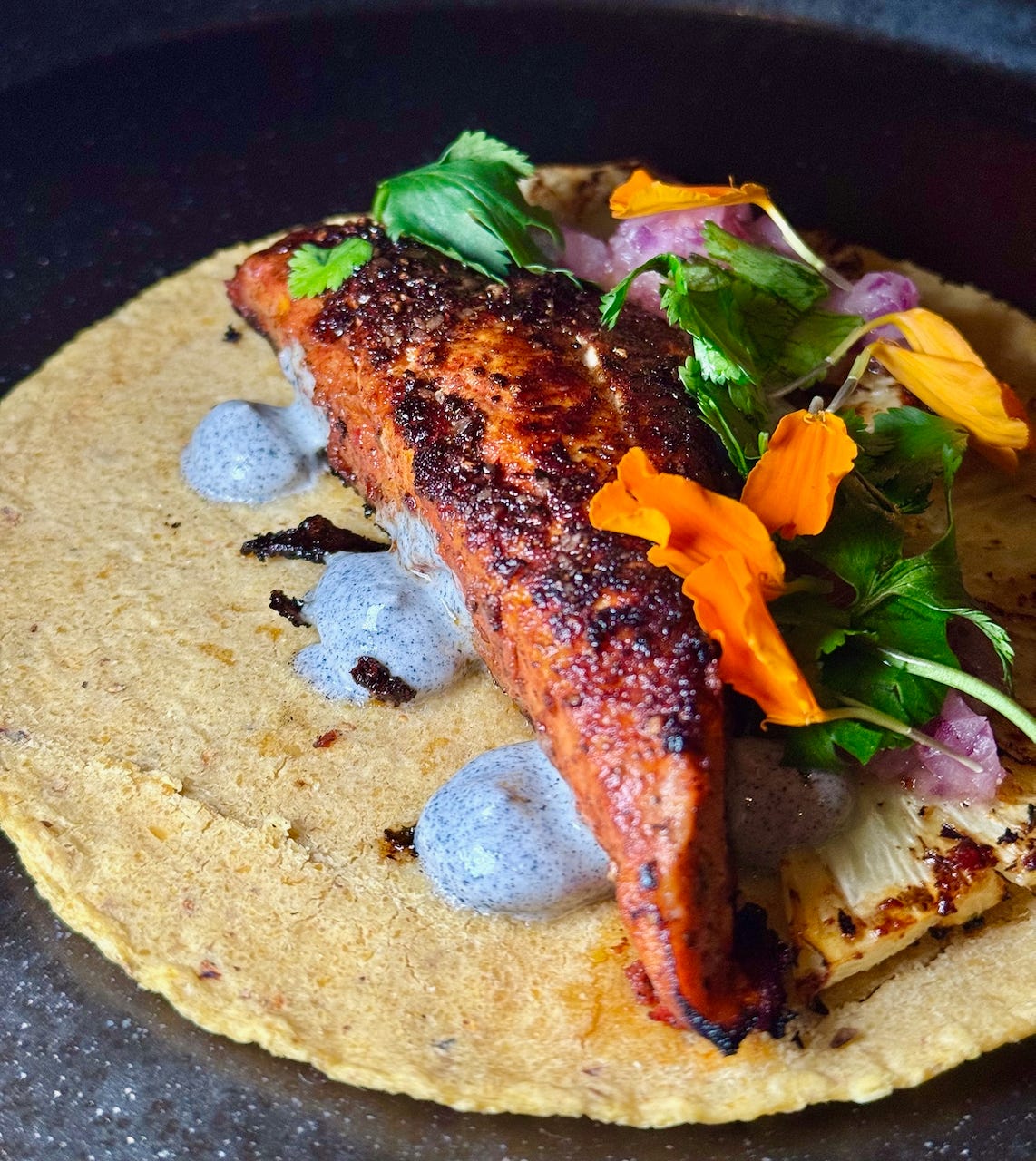Spicy noodles, pork head, mezze and the sweet corn illusion 🍽
Recent dining and drinking in Denver — part two. MAKFam, La Diabla Pozole y Mezcal, Ash'Kara and Xiquita.
In part one last week, I detailed our stay at the Populus Hotel and some nearby meals we ventured to. This week, I want to focus on a trio of Michelin Bib Gourmand-winning spots that are generally easier to access sans reservations and more affordable than the higher end options. And we hit another spot (recommended by a Denver media friend) that’s potentially deserving of the list when the next awards are evaluated. Let’s go:
MAKfam

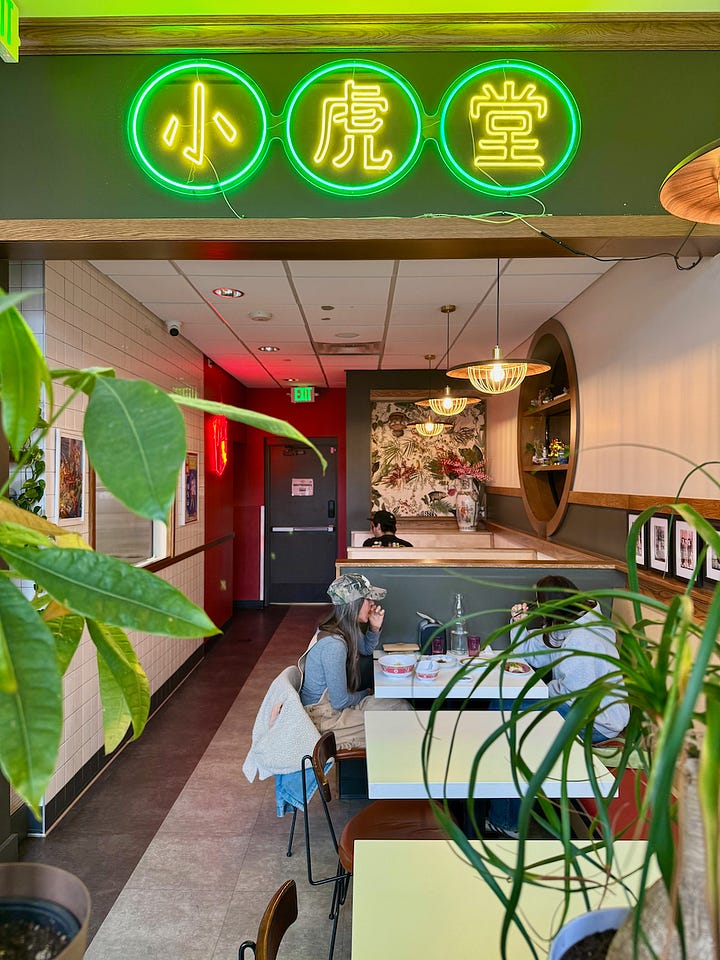


MAKfam opened in October 2023 just off Broadway and First Avenue, earning Michelin Bib Gourmand status in 2024. Catch the owners’ brief backstory in this Westword writeup by Molly Martin, who told Side Dish readers last fall to make the effort to venture to the Cantonese-inspired spot (and Xiquita, which we’ll get to below). As another primer, it’s also worth reading this other Westword piece by Helen Xu on why MAKfam is proud to use the stigmatized and misunderstood ingredient MSG.
We stop in late afternoon for a small bite at the bar. For drinks: a cooling, N/A mix of coconut milk, mint and lemon with butterfly pea flower for color impact. And the tropical-spun Emerald Fang, served in a cool snake cup (fit for the Harry Potter theme at Allusion Speakeasy), featuring baijiu, amaro, salted banana, black sesame, pineapple and lemon. With layered sweetness under the forward spirits, the sesame in particular fades in and out in a unique way as you sip.
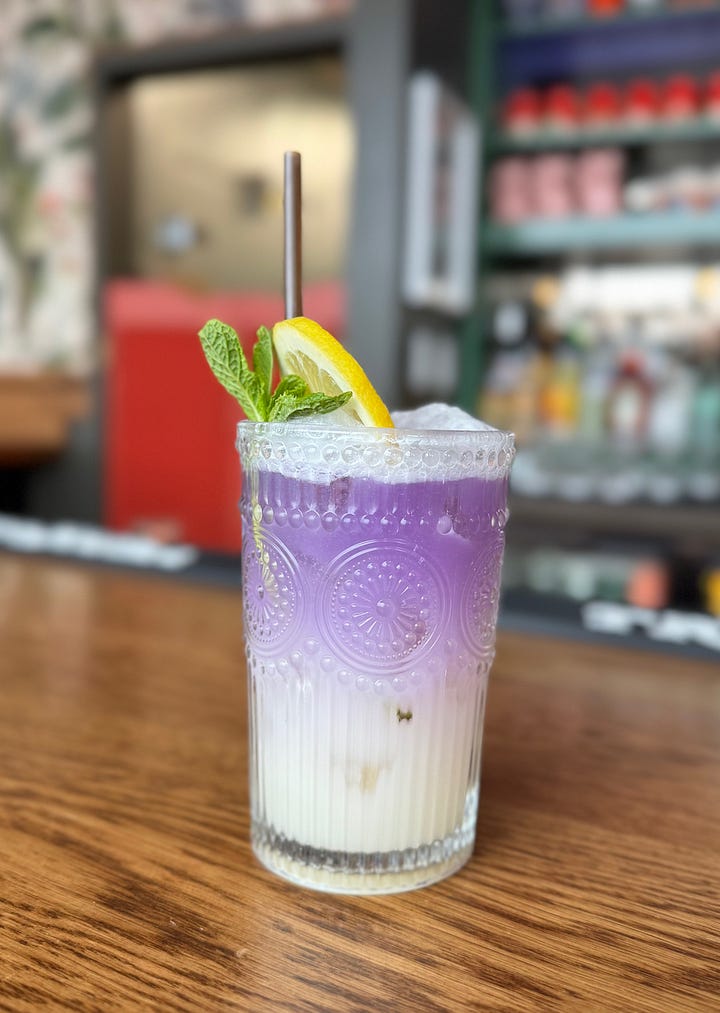

For eats: Fancy Wun Tun Tong, a bao bun trio and the Sizzling Spicy Noodles. House-made shrimp and chicken dumplings, shaped like oyster shells with a pinched bump in the middle, compose the first dish. They’re set afloat in a divine, slightly peanut-y chicken broth spiked with XO sauce, a complex red chile paste. We devour the dumplings and drink down the oily, warming broth.
For the bao buns, we try one of each on the menu: braised pork belly, spicy chicken and marinated shiitake (vegetarian). All get pickled radish for acidity and sesame seed garnish plus either scallion or cilantro. Spicy mayo pops the chicken and a Thai basil ranch adds bright herbaceous flair to the fungi umami. But it’s the hoisin on the pork belly, with prominent star anise flavor, that blows our hair back, rendering our eyes wide after our first bites. (Or maybe it’s MSG too; I dunno.) I write down “epic … fuck” in my phone notes, inelegantly. We’ve eaten plenty of pork belly bao over the years and none are as immediately impressive and memorable as this one.

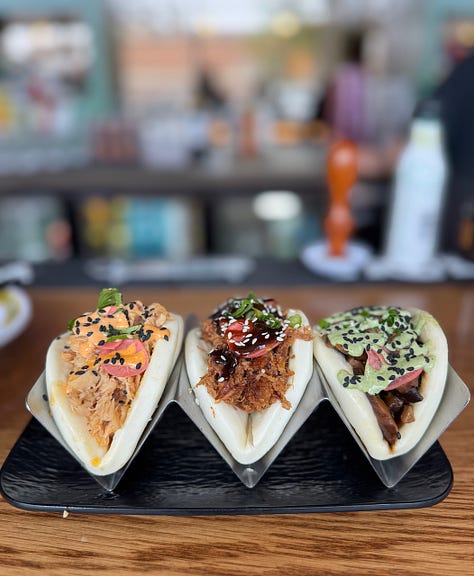
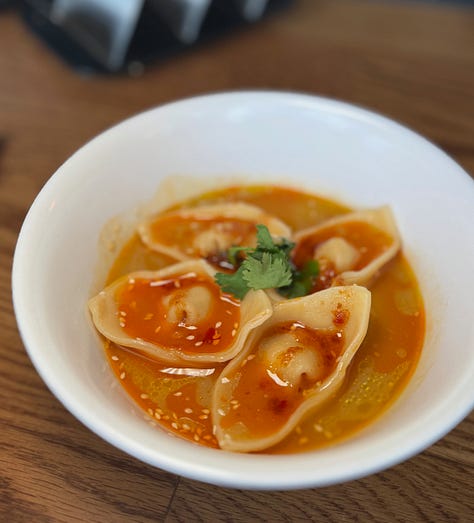
That leaves the Sizzling Spicy Noodles, which we keep vegan, though you can add any of those bao bun fillings or crispy tofu. I order the dish off our bartender’s recommendation and don’t take the time to study the menu closely, so it’s a surprise when my tongue starts going numb across the top and my mouth starts tingling as if I’ve nibbled the corner of a buzz button flower. Just as I’m writing “WTF?” to-self, I read that in addition to house chile oil, the simple noodles and steamed cabbage also contain mala seasoning, made from Sichuan peppercorns that might leave you sweating a bit. The dish is no-joke hot, but so delicious the we power right through it, feeling a little euphoric-buzzy afterward from the endorphin flood it inspires.
La Diabla Pozole y Mezcal
Chef Jose Avila — also renowned for his Sunday-only El Borrego Negro barbacoa service — earned a Bib Gourmand award in both 2023 and 2024 for this unassuming Larimer Street eatery near Coors Field. There’s not even a sign on the facade of the small brick building, much like there’s only an Instagram page for El Borrego Negro. Meaning when you’re damn good at what you do, people will find you and the mysterious aspects only serve to further create hype and IYKYK-cool-kid-club credibility and legitimacy. A knowledgable foodie friend in Denver — who at times we’ve lovingly called Grumpy Cat because his standards are so high — tells me Avila is his favorite Denver chef right now. That’s all I need to know.
We make our way down to La Diabla for weekend brunch at the unfortunate time when a Colorado Rockies game happens to be starting, which I didn’t realize, so I’m greeted with zero street parking options in the vicinity and highly inflated “Game Day!” pricing in a lot across the street. I may has well have pulled a $20 bill from my wallet and lit it on fire I felt so fucked by the transaction. (Sure, I could have looped around to farther away lots and hiked in, and I don’t normally mind the mileage, but I don’t know the lay of the land well there and our time also mattered that day.)

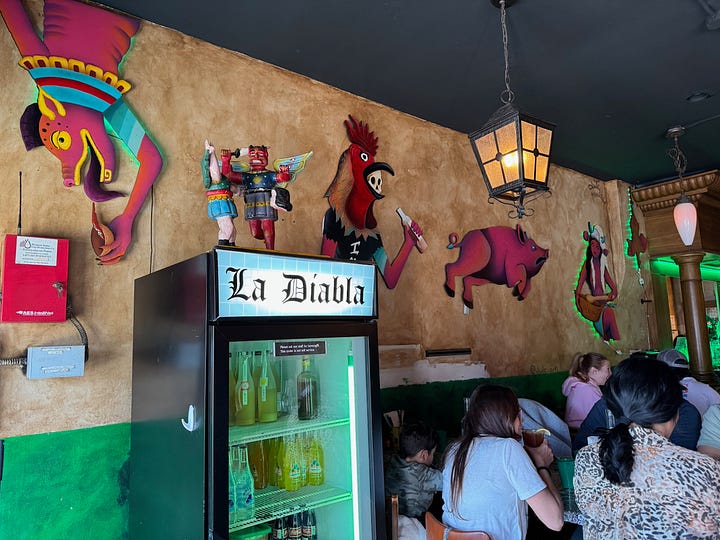
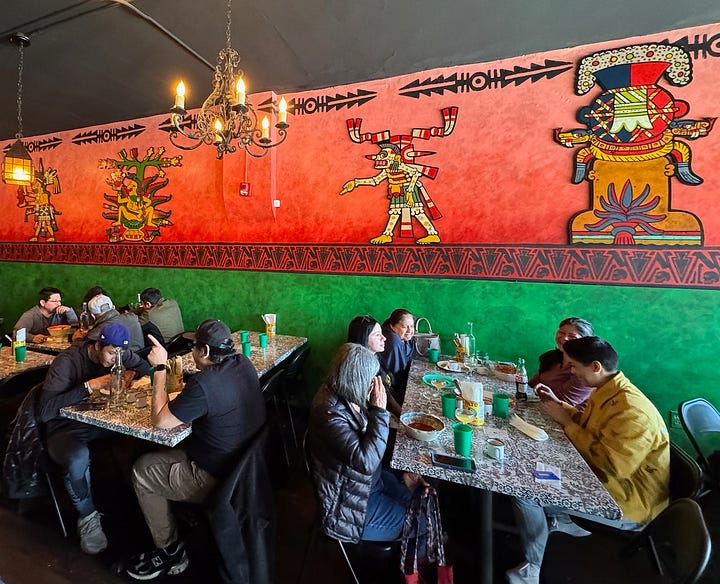

Brushing off the inadvertent insult, we went inside and were seated at the bar, admiring all the colorful wall installations and mural work on the way. (I later ask a staffer if the iconography is Aztec or Mayan, and she says she doesn’t know, leaving us both feeling like super gringos, as we are, though in my defense I don’t work there and she should probably find out.) While we’re studying menus our bartender brings over samplings of the rojo caldo pozole broth for us to try, sipped from little metal cups. It’s lightly spicy and abundant with earthy, herbal flavors from chiles and I can only guess how many other spices and seasonings. But I’m drawn to order the pozole negro (typically black beans, corn and chicken broth), choosing cabeza de cerdo (meat from a pig’s face/head) as my protein (over a pollo option) and adding an egg and avocado to make the whole affair creamier and richer. (All in that’s $24.) The menu’s a bit spartan on details, so definitely ask what questions you care to before committing.
As much as I’m tempted to get the chilaquiles or another breakfast-y item, we want to sample the tacos ($4 on happy hours, overlapping brunch) that friends have rated higher than the pozole. So we order carnitas and pollo en pipián, with a side of tuétano (bone marrow) for $5. The bone marrow’s an over-the-top game changer that’s still under the radar, and I hope other taco spots locally pick up the idea (a trend in trendier places) and run with it. We scoop bites of the gelatinous fat, dusted with seasoning on top, and add them to taco bites to amplify each’s unctuous qualities; it’s akin to adding a dollop of foie gras to a burger or something else sinfully lavish.
The chicken on the taco’s chunked, moist and super tender under a thick mole verde sauce and fine-chopped matchsticks of raw radish for garnish. It’s an impactful bite on its own before the bone marrow adjunct fully sends it. Ditto with the carnitas, covered with pico relish, salsa roja and including bits of cucumber and chicharron for garnish. The pozole meanwhile can feed two people, in a big bowl served with a couple tostadas on the size plus a halved lime and bright pink plastic hand juicer (which leaves me feeling like I’m at a deli attached to a carniceria or mercado somewhere, which is to say charmingly transportive as a meal prop). The starring hominy component alone is so filling to the belly and our egg and avo additions prove wise choices to further bulk out the broth, itself milder than the rojo we sampled, so we do pour in a side of chile oil presented to us as well.
I find that I like eating pozole as a breakfast item as much as any other time of the day, and more than I’ve liked eating the famous hangover soup menudo. It feels nourishing to the body, even if we betray that with a Bloody Mario — a Bloody Mary alternative with mezcal in for the typical vodka. La Diabla’s comes thin and more watery than tomato juice thick, dusted with a chile rim. House hibiscus agua fresca offers a hydrating counterbalance and a tart palate cleanser throughout the meal. On the whole we’re quite pleased with our first visit, excited to try more in the future — hopefully far away from a Rockies game day.
Ash’Kara
Ash’Kara dates back to late 2018 in Denver’s hip LoHi neighborhood and I’ll say upfront it’s the only one of our Michelin Bib Gourmand stops that leaves us wondering how it made the list in both 2023 and 2024. It’s generally good, great at a couple turns for us, but on the whole much less impactful than fellow Israeli/Mediterranean Michelin Bib Gourmand earner Safta (at The Source Hotel + Market Hall), which we’ve relished on past Denver visits.
The space is bright and open, with Middle Eastern lanterns suspended in a long row over the bar counter and a simple pastel color pallet. Service is pleasant but sluggish during our visit, also a little less than helpful when it comes to understanding portion sizes and ordering family style for our group of six. (We met old friends for lunch.) For example when we order one of each mezze (starter), he says “all of them?” in a tone seemingly to imply that’s a lot of food, so we go easy on next courses thinking we’ll be full. Turns out it’s a perfect shared sampling and we’ll all placing second-round orders for more once we discover that. No biggie (unless we’d been on a time crunch, or they had to flip tables), but given how much pomp and pageantry Michelin seems to award at the higher levels (as we experienced last fall in Portugal), we’re a little surprised by the lackadaisical pace of it all, including poor pre-bussing, delayed check-ins, etc. (And yes, I can give grace that parties of people socializing as much as eating, as we were, can be harder to read when it comes to timely hospitality.)

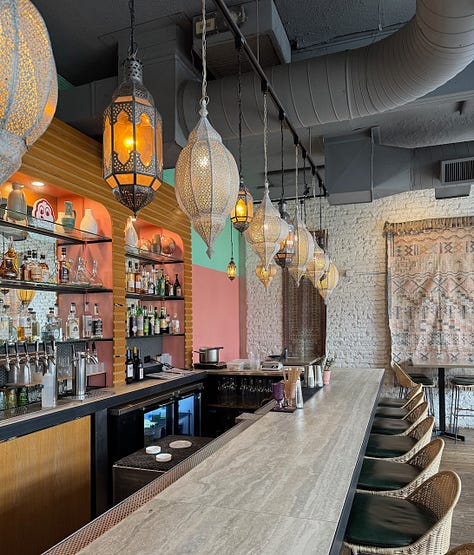

To the mezze, plan to skip the wholly unremarkable pickled carrots, beets and cucumber (unless you wish to self-garnish a sandwich or wrap), and there’s nothing wowing about dolling up Castelvetrano olives (the delightful ones you can get a giant jar of at Costco for $10 or under) with orange zest and Calabrian chile powder for $7 for what amounts to a handful. The babaganoush too underwhelms, bordering blandness and certainly lacking a deep, smoky, charred eggplant essence we want to see (à la Safta if I must compare again). Hummus is better than that and most on the market, but my next comparison point/place is Hamsa Hummus locally and it remains in a league above them all for me.
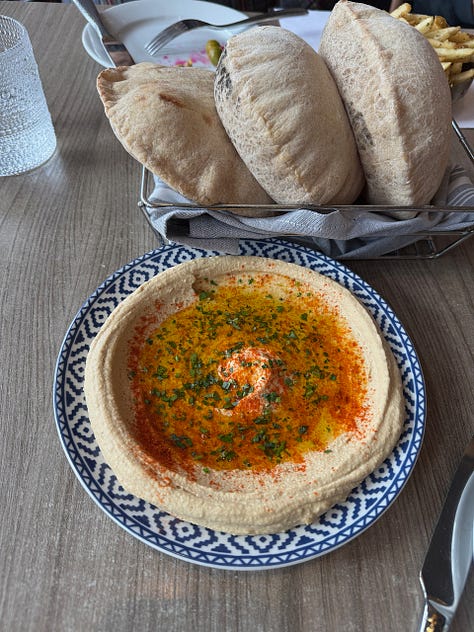
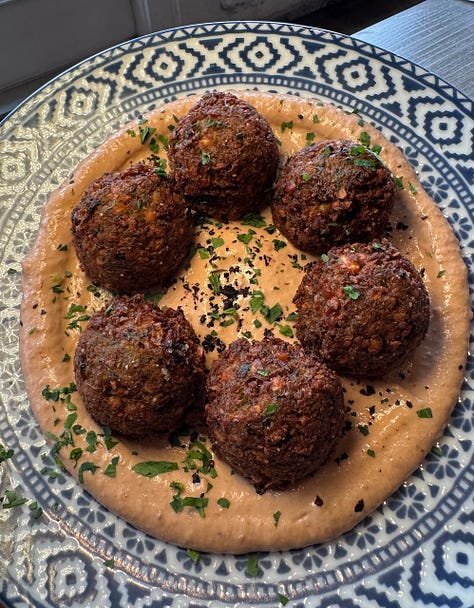

The falafel is fine and we do dig the underlying tomato-tahini sauce with it. The Htipiti roasted red pepper and feta dip with minced Kalamata olive garnish eats brightly vegetal and piquant. But the whipped labneh is the winner of them all, sweet with honey, covered in a sumac dusting and sesame seed garnish and just pure delight all the way through. I haven’t mentioned the house heritage-grain, wood-fired pita, which arrives in puffy flying saucer shapes. It’s wonderful for its part in scooping and dipping through all of the above.
For our mains, we order a sesame seed chicken schnitzel off a special “Jewels from Jerusalem Passport Series” menu, and the lamb kofte pita sandwich from the regular menu. ($14 and $17 respectively, so Ash’Kara is no wallet buster at lunch). The first comes on a challah roll with pickled cabbage, mango amba and Israeli eggplant relish according to the menu, but as I’m looking now at my photos I don’t recall (and was distracted from taking good notes) why there’s a side of tzatziki with it. Anyway, the chicken was fried crispy for a good crunch-bite and I remember liking the sandwich well enough.
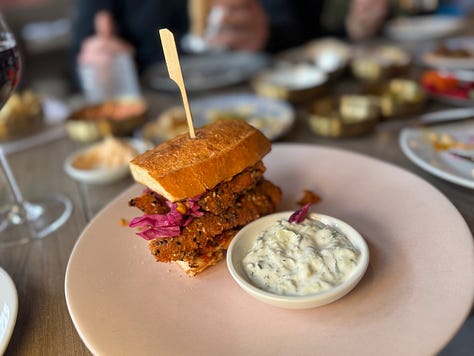
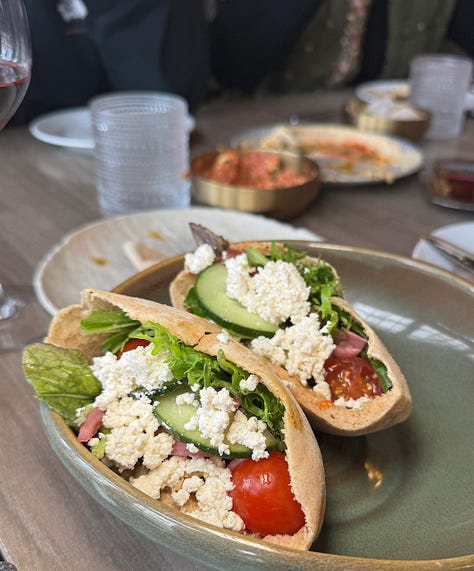
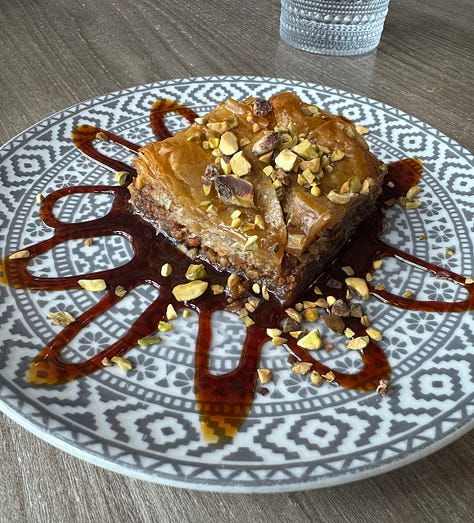
But the lamb kofta steals the show and makes for the best bite of our whole spread — finally an item that I understand a critic would fawn over a bit. The meat’s vibrant with bright spices, including something interesting that reads bitter-citrus to me almost in a shiso leaf way. I inquire and am told its just more sumac, which surprises because I don’t taste it the same way in the aforementioned labneh (perhaps because of the counterbalancing sweetness. But it makes total sense given the mild astringency. Anyway, it’s awesome. As is the lemon-pepper tahini sauce coating the bottom of the open pita, topped with mixed lettuce, cucumber, pickled onions, tomato and generous crumbled feta.
Ash’Kara finishes strong as well with their house baklava, beautifully presented and traditional in form. The phyllo and walnut paste is soaked sappy with cinnamon-laced honey and a rain of garnishing pistachio crumble. So, as I said above, I find the place generally good and great at turns (which you can now identify), so you should still check it out to form your own opinion at some point. I want to stop short of calling it not Michelin deserving, because I haven’t dined from the dinner menu (which in-part features tagine dishes) and would want more visits before levying a serious judgement.
Xiquita
Xiquita opened in Uptown Denver in August, 2024 and is a sister restaurant to Lucina, which opened in Park Hill in 2022. Westword food writer Molly Martin placed Lucina on her Michelin snubs list in Side Dish last fall. About Xiquita, she said, “The passion they all have for honoring their Mexican heritage and the depth of that country’s culinary history really comes through on every plate.” (Both entities are also part of Create Kitchen & Bar, which offers cooking classes and summer camps.)
I confess we were trying initially to find a way into heavily-booked-up, Michelin starred Alma Fonda Fina to knock another Michelin off the list (for research as much as enjoyment on my end). But Xiquita’s name kept coming up as recommended so I don’t feel like we were settling in any way to hit it too. I’m so glad we did, as we were enamored from the get-go and now inspired to both return and explore Lucina. (One life’s time, one stomach, one hour-plus drive from the Springs … so sad for me.)
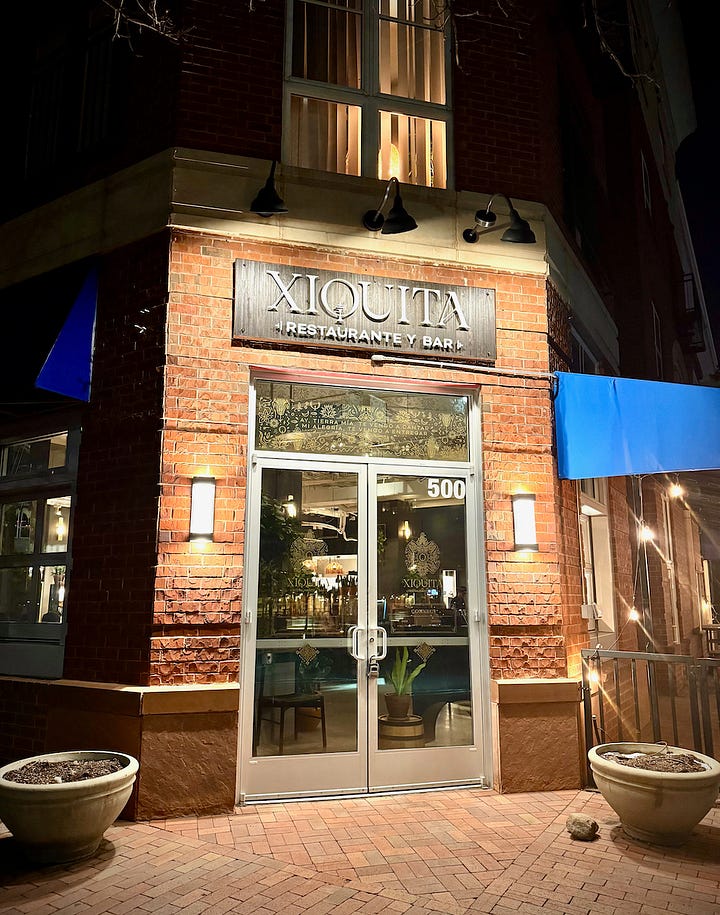

To get right to it, both our Martini Sucia and Hidalgo Negroni are exceptional cocktails. The first features Mexican Condesa Gin with cilantro-infused vermouth and green onion shrub, resulting in botanical bliss. The classic Negroni spin gets sotol (a beautiful cousin to mezcal and tequila), Granada Vallet (an amaro-like Mexican herbal bitter liqueur), Xocolatl (spiced chocolate)-infused vermouth, Nixta Licor (Mexican corn liqueur) and Morita chiles (smoked ripe red jalapeños). The fact that I felt compelled to give explainers to every one of its ingredients gives one indication to its unique complexity. I didn’t even mention yet that the rim gets a smear of caramelized white chocolate and black lava salt. It’s all obscene in the most hedonistic, brain-exciting way, especially with the linger of the Morita heat, which isn’t insignificant and shows the chutzpah of a place that’s not afraid to burn you a little and push palates forward. (Read: not cater to gringos or worry if the market will bear it, as so many chefs feel forced to do to finicky eaters and drinkers.)


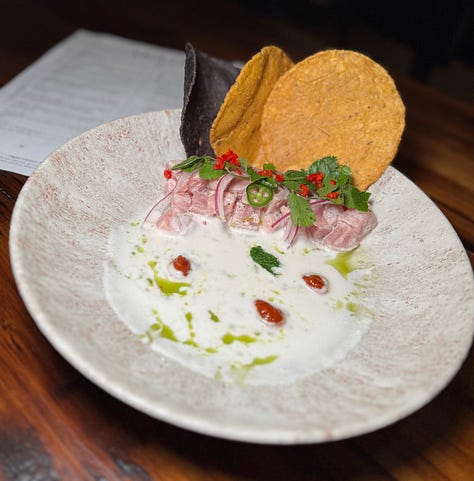
I must sound like I’m gushing already. I am. Don’t care. I’d drive back to Denver for this drink alone I now think. But obviously I wouldn’t have to because I’d be ordering more of the food we didn’t get to try and definitely a repeat of the phenomenal ceviche. It’s cured tuna with a coconut milk broth, onion, jalapeño coins, cilantro and garnishing color pops (what looks like cilantro oil and a chile paste; I forget to ask). It’s not exactly a leche de tigre sauce it doesn’t seem, but consider it in the realm. It’s light, lovely and intoxicating in its own way, to be eaten with accompanying blue and yellow corn tostadas. (I failed to mention the freebie greeting dish of nixtamalized tortillas with a quenelle of herbed butter.)
Next up are the Huarache and taco de pescado (pictured in the intro). Huarache gets its name from Mexican sandals, hence its long oval masa dough shape. Atop there’s a bounty of fatty pork belly bits, crumbled chorizo and browned potatoes, covered half-and-half with salsa verde and roja and garnished with crumbled queso fresco, onions and cilantro. It doesn’t eat as heavy as it sounds, but certainly feels filling. The sauces in particular make it sing. The fish taco starts with one of the thick nixta tortillas, which gets a sizable blackened, al pastor kanpachi (amberjack) strip, grilled pineapple pieces, red onions, cilantro, orange flower petals (nasturtiums or marigold? I forget to ask) and a corn ash crema. In a word: wow.
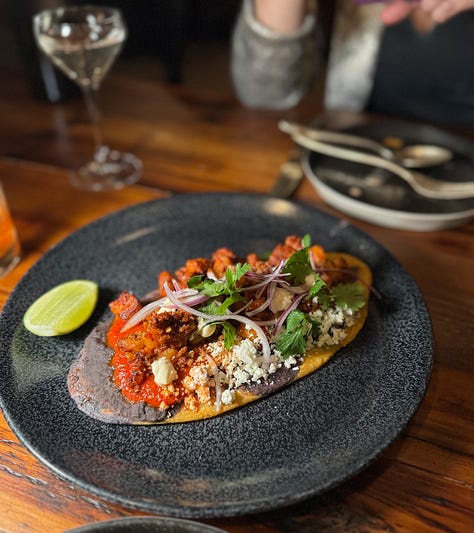
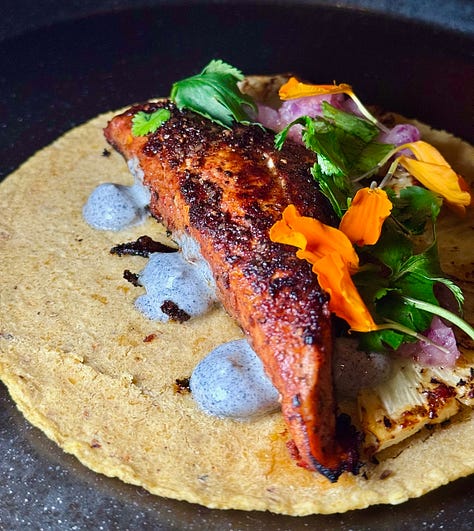
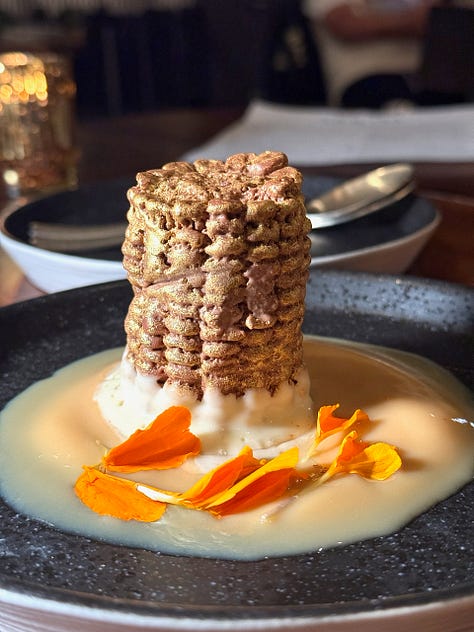
Last comes the Tezcalate dessert, gorgeously presented with more flower petals and a golden-colored chocolate corn cob mold anchored in white chocolate that you cut open to reveal an achiote (annatto, a key spice in cochinita pibíl) and canela (cinnamon) ice cream. An underlying cajeta- or dulce de leche-like sauce (that again I neglect to ask about) adds a decadent caramel-y component and the whole affair’s just terrific with the spice undertones.
Parting thoughts
Part of why I sought to check out some Denver Michelin-earning spots was to compare them to the finest of what Colorado Springs has to offer. As I wrote about in September, 2023 here, the Springs declined to pay-to-play for Michelin consideration the past couple years. That’s left some chefs I speak to regularly still sour about the matter. They feel we should pony up for prestige and put ourselves on the map, even if it’s just for a handful of Bib Gourmand nods, short of stars.
I’ve pondered the matter myself with some consistency, and this visit to Denver helped clarify at least the entry level to Michelin greatness. If Ash’Kara can do it, I’m more confident some spots in the Springs can too. Probably Pizzeria Rustica for a Green Star, as it has been a 4-Star Certified Green Restaurant for years. It’s quite plausible to believe spots like Cowboy Star, Ambli Global Cuisine, Four By Brother Luck, Ephemera and Summit at the Broadmoor would land Bib Gourmands, perhaps a single star somewhere between one of them?
I would hope the authenticity and longevity of places like Margarita at Pine Creek would shine through for consideration, too. Maybe Eleven18 Latin Tapas Bar’s superior cocktail program and tasting menu from its DJ/chef would equate to the offbeat edginess of a La Diabla in the eyes of a Michelin judge? When Chef Fernando Trancoso eventually launches Inefable again, he’d be a likely contender based on what we saw in the first incarnation. This is just a short list, shooting from my hip, and I’m probably missing something you might shout out. (A Joseph’s, Marigold, Carlos Bistro, Prime 25?)
Let’s consider this an ongoing conversation, and for my part I aim to explore more in Denver/Boulder in time, at the pricier spots too. Get up there if you can to help weigh in; you’ll at least have a good time researching. Michelin isn’t perfect and it’s not everything. I’m glad to have already discovered two questionable moments for myself in my limited samplings here and abroad. But they do provide a useful roadmap and weed through hundreds and hundreds of places to narrow down to the cream of the crop. From there, it’s important to follow your area journalists and food writers who’ll keep tabs on the snubs and the newbies who enter the market. I’ve provided enough links in these two Denver write-ups to get you started. Have fun; we’ll chat about this again sometime.


